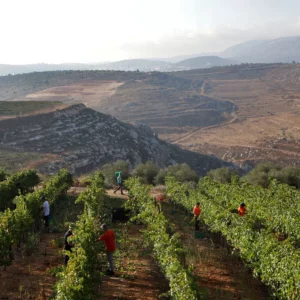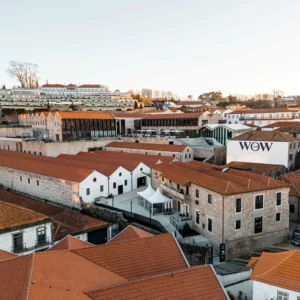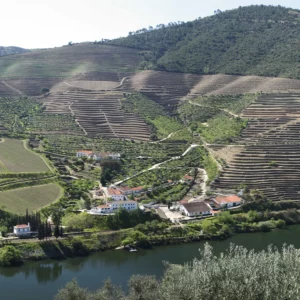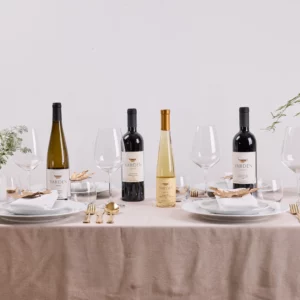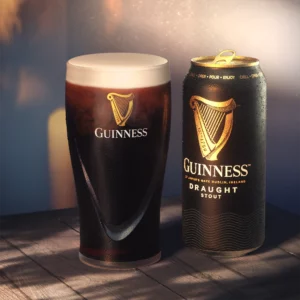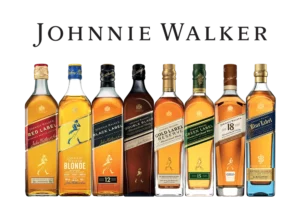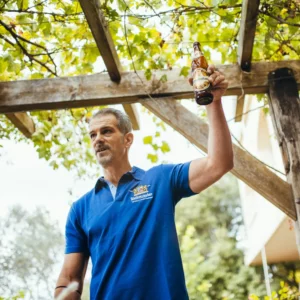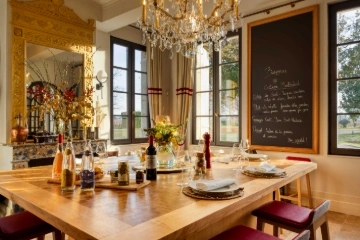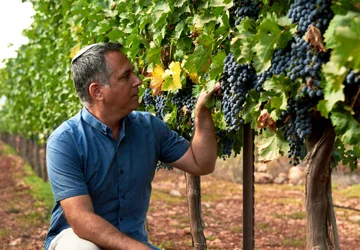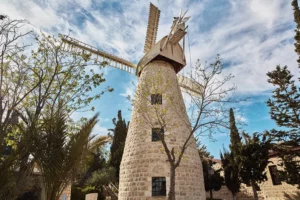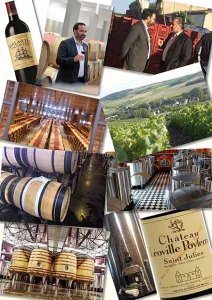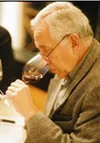If I was asked to name two characteristics of Israeli wine, I would point out the sheer diversity and variety. Israel, though tiny, has a number of different terroirs and microclimates, like many long, narrow countries, for example Italy and Chile. The differences in the growing regions ensure Israel has an unusually long harvest, from mid-July until the end of October. Our wine revolution is forty years old. Maybe it is time to consider what grows well where.
A Master of Wine recently asked me to name the most suitable individual grape variety for each Israeli wine region. There are only 400 M.W.’s in the world, therefore he is important, so I thought I had better answer him. However, there are three issues to be understood before embarking on this task. Firstly, many wineries, at least certainly the larger ones, make wines from multi-regions, so the issue of regionality, may not be that meaningful. Thankfully we are talking more these days about regions, sub-regions, vineyards or even individual blocks or plots. Secondly, though once Israeli wine was predominately varietals, things are changing. A varietal is a wine named after the dominant grape variety, as long as it represents a minimum of 85% of the wine. However, the trend is also more to blends, on the premise that 1+1 can equal three. Finally, in truth it is not a fair exercise, because many varieties are first class in a number of regions. Anyway, I rose to the challenge, and thought I would share it with you.
A similar article first appeared in the Jerusalem Post
The Golan Heights in the north east of the country is a volcanic plateau. For me the grape variety that shows best on the Golan is Cabernet Sauvignon. This is the king of grapes, most famous in Bordeaux and Napa Valley. In Israel it is our most planted variety and it is arguably the most successful brand here. Most of the prestige or flagship wines of the finest wineries, are Cabernet varietals, or blends based on Cabernet Sauvignon. The key areas are the Central and Northern Golan Heights. The ground breaking Cabernets in Israel were a long time ago. The first international style wine aged in small oak barrels, was the Carmel Cabernet Sauvignon Special Reserve 1976. However, the first which showcased the Golan Heights were the ones which put Israel on the world wine map. These were the Yarden Cabernet Sauvignons of 1984 and 1985. Today the Yarden El Rom Single Vineyard Cabernet Sauvignon, Yarden Cabernet Sauvignon and Gamla Cabernet Sauvignon are the classic cabs from the Golan Heights at different price points.

For the white I choose Gewurztraminer. The Northern Golan is our coolest climate, and it is exactly what Gewurtz needs. It produces wines in dry and semi dry styles and also luscious dessert wines. The Golan Heights Winery was the pioneer of this variety (apart from the Latoun Monastery) and I remember the initial concern no one was buying it because they could not pronounce it. How things have changed.
The Galilee in the north of the country is a region of hills, valleys, forests and streams. The best varieties in the Upper Galilee are what can be categorized as the Bordeaux varieties, in particular Cabernet Sauvignon, Petit Verdot and Cabernet Franc. Cabernet Sauvignon is taken and Petit Verdot is reserved for later, so let’s narrow it down to Cabernet Franc which gives particularly good results in this region. The outstanding Cab Franc that brought our attention to this variety was the Margalit Cabernet Franc 2001 and it remains the standard. One of the best of the current expressions is the 1848 Winery 5th Generation Cabernet Franc. Neither come from the Galilee, but the variety mainly shows as part of Bordeaux style blends. When Baron Edmond de Rothschild first brought Bordeaux varieties to Israel, they were brought from a Kashmir nursery which was free of phylloxera. They were known as ‘the Indian vines.’ Interestingly, in the late 19th century, more Cabernet Franc was planted than Cabernet Sauvignon!
In the Galilee, Sauvignon Blanc is also successful producing some of our finest wines made from this aromatic variety. Some of the best Sauvignon Blancs from the Galilee are those of Shvo Vineyard and Tabor Winery. In fact if I was strictly by the book, I would have written Cabernet Sauvignon and Sauvignon Blanc as the finest varieties for both the Golan and the Galilee….but that would make the game too easy! The first famous Sauvignon Blanc was the Yarden 1983, termed at the time in the USA as “Israel’s first world class wine.” Dalton Winery was one of the first to signal that the Galilee was a good home for Sauvignon Blanc.
The Coastal Plain runs down the Mediterranean coast. The Northern Coastal Region encompasses the Zichron area, in the valleys of the Southern Mount Carmel, and Hanadiv Valley. The variety most at home in this region is Carignan. Most at home in the South of France and Spain, this has been here for 150 years and it is really our adopted or heritage variety. Many of the vineyards are old vines, growing as bush vines. Margalit was the first winery to make a quality Carignan in 1999, but it was a one off. Vitkin Winery was the pioneer who really showed what could be done with old vine Carignan from the 2002 vintage onwards.
For the Southern Coastal Plain, south east of Tel Aviv, I have selected Muscat of Alexandria. This is possibly our oldest variety, which is indigenous to the Eastern Mediterranean and North Africa. Traditionally used for dessert wines, here it thrives because of the success of Moscato, the grapey, low alcohol, lightly sparkling sweet wine. The Yarden Muscat Dessert Wine 1988 was the first higher profile wine made from this variety, but it was discontinued after 2015. The Private Collection Muscat was the most notable from the Coastal Region. (In those days Private Collection was the premier label of Carmel Mizrahi.) The majority of today’s Moscatos are made from this variety, the exception being Hermon Moscato, which was always made with the superior Muscat Canelli / Muscat de Frontignan variety.
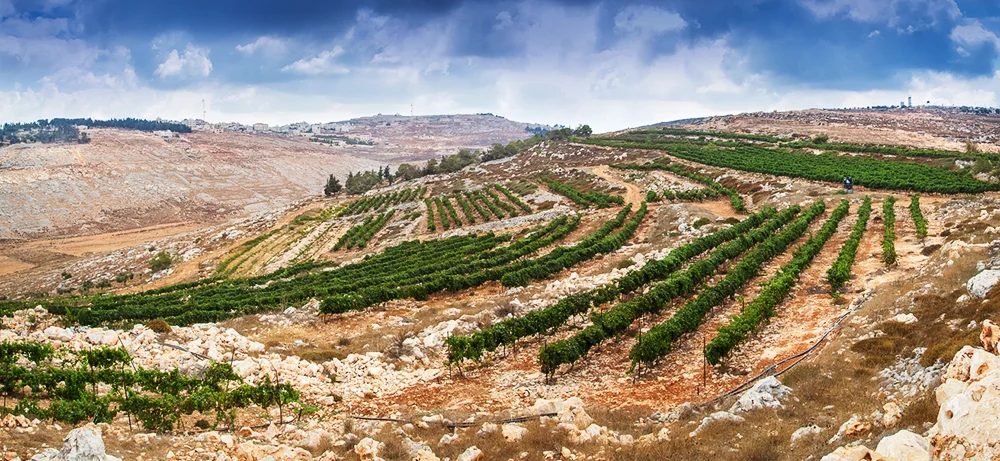
In the Central Mountains, aka Judea and Samaria, the variety that shines is Merlot. This grape variety is an integral part of the Bordeaux blend, which comes into its own on the Right Bank of Bordeaux, in Pomerol and St. Emilion. The Yarden Merlot 1988 was the first Israeli Merlot to be awarded a major international prize. The Carmel Har Bracha Vineyard Merlot 2002 was the first flags up about the quality of Merlot in this Biblical mountain strip. This wine was a one vintage wonder but it did encourage new vineyards to be planted in the Central Mountains Region and the founding of new wineries. Thus paradoxically, our oldest wine growing area historically, became our youngest and newest wine region. I particularly respect the Merlots produced by Gvaot, Shiloh and Tura wineries.
There is a new interest in the native varieties of the Holy Land. These include the Dabouki and Hamdani/ Marawi. These survived during the period of the Ottoman Empire in the southern area of the Central Mountains because they were used as table grapes and for use in making dibs (grape syrup). These varieties are most at home in the Hebron region of the West Bank, or the southern part of the Central Mountains Region. The heaviest planted variety in this region is the Dabouki and it also the one of these Palestinian varieties most known in Israel, where it used to be grown for distillation into brandy. The pioneer in making Dabouki is the Cremisan, the monastery winery at Beit Jalla, near Bethlehem and Feldstein Winery produces the best one.
In the Judean Foothills, the rolling hills wedged in between Tel Aviv and Jerusalem, I have chosen Petite Sirah and Colombard. These are two varieties that made aliyah here in the 1970s with no pretention to quality whatsoever. They were hidden in inexpensive blends. I suppose the Petite Sirah gave color and the Colombard provided acidity. It is only more recently that it has been understood how suitable they are for Israel climate and terroir. The Vitkin Petite Sirah 2003 was the first which showed the potential of this variety. The first varietal Colombard I noticed for its value was produced by Mony Winery from the 2009 vintage. For some reason, Israelis insist on calling this French Colombard, but believe me, Colombard on its own is perfectly adequate.
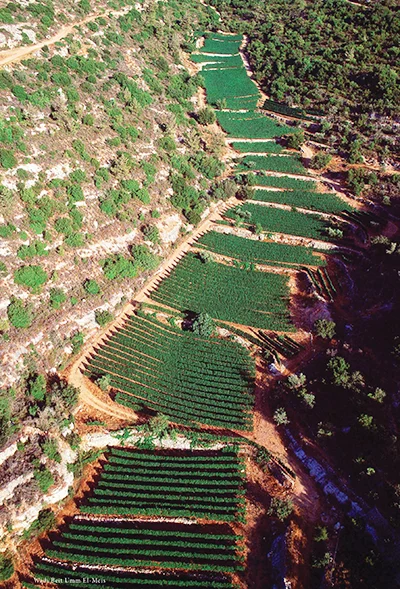 The Judean Hills is the area that sharply rises after Beit Shemesh from 400 meter elevation to over 800 meters. As with the Upper Galilee, it is disingenuous to filter down to two varieties, but understanding the rules of the game, my choice is Syrah and Chardonnay. In fact Syrah (aka Shiraz) grows well all over Israel. The first to gain international notice was the Clos de Gat under the Harel label. Their first vintage was the 2003. That was also the first year of the Kayoumi Vineyard Shiraz produced by Carmel Winery. Their 2006 won a very major international award, announcing to the world that Israel makes high quality wines from this variety. The Flam Syrah Reserve is a fruit forward example, and Razi’el Red and Tzora’s Misty Hills show the success of this variety as an important component in these prestige wines.
The Judean Hills is the area that sharply rises after Beit Shemesh from 400 meter elevation to over 800 meters. As with the Upper Galilee, it is disingenuous to filter down to two varieties, but understanding the rules of the game, my choice is Syrah and Chardonnay. In fact Syrah (aka Shiraz) grows well all over Israel. The first to gain international notice was the Clos de Gat under the Harel label. Their first vintage was the 2003. That was also the first year of the Kayoumi Vineyard Shiraz produced by Carmel Winery. Their 2006 won a very major international award, announcing to the world that Israel makes high quality wines from this variety. The Flam Syrah Reserve is a fruit forward example, and Razi’el Red and Tzora’s Misty Hills show the success of this variety as an important component in these prestige wines.
The Judean Hills has proved also to be a truly fine region for white wines. The number of outstanding white wines from this region is noticeable and the Chardonnay from here is as good as anywhere else in the country. The C Blanc du Castel 1998 was the first Chardonnay from the Judean Hills to bring attention to the area, and it is still the most Burgundian Chardonnay in Israel. The white wines of Tzora and Sphera support this theory.

Then, finally we have the Negev. This is our smallest wine region in terms of vineyards, but the largest in terms of area, making up over 50% of the country. The Mitzpe Ramon area is the hub of vineyard activity. The main variety that shows well here is Chenin Blanc, which is at home in the Loire Valley. The pioneer in reviving Chenin in Israel is Sea Horse Winery starting with their 2007, followed by Shvo Vineyards. The Negev has proven to be better for whites than reds, and the Chenin Blanc seems to thrive there. The Nana Chenin Blanc is the flagship for Chenin in these high elevation vineyards.
Red is more challenging in the Negev, but for my red variety I have selected Petit Verdot. This could have been the choice anywhere in Israel, including the Upper Galilee, and Syrah also shows nicely in the Negev. Petit Verdot is a variety barely featuring in Bordeaux, but in Israel it ripens well and is proven as a successful blending variety. The Yatir Petit Verdot from the 2006 vintage onwards has been a rare and high quality varietal showcasing this variety. The Ramat Negev expression is also good. It is an excellent variety which shows well in the Negev.
Please understand that this is not an exact science, but I have fulfilled the brief. Just don’t take it all too seriously. It was a fun exercise nonetheless!
Adam Montefiore is a winery insider turned wine writer, who has advanced Israeli wines for 35 years. He is referred to as the English voice of Israeli wine and is the Wine Writer for the Jerusalem Post. www.adammontefiore.com




